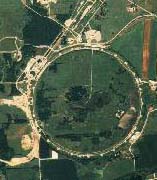 |
ACCELERATION
| |
|
DAVE FINLEY. Acceleration is a change in speed or direction. When I drove to work this morning, I used the gas pedal to accelerate, the brake pedal to decelerate, and the steering wheel to change direction. Occasionally, the road surface caused a change in direction vertically . All of these are examples of acceleration. Fermilab accelerators increase the speed of protons by increasing their energy . We change the energy of a proton by putting it in an electric field that interacts with the positive electric charge of the proton. To get protons started, we pass them through an electric field that gives them an energy of 750,000 electron volts: the voltage times the electric charge of the proton. Then the protons enter the Linac, where we carefully synchronize the electric field by applying a voltage at just the right time so that when the protons pass by they get a nudge in the right direction. The nudge comes from a device called a radiofrequency, or rf, cavity. The protons pass once through a series of these cavities in the Linac and come out with an energy of 400 million electron volts. One thirtieth of a second later, at their next check point, the Booster has increased their energy to eight billion electron volts. The circular design of the Booster and the later accelerators allows us to use a single rf cavity over and over again to accelerate the protons, cycling them through the same cavity many times. The Main Ring takes protons to an energy of 150 billion eV. Up to now, the final accelerator, the Tevatron, has taken protons to energies as high as 980 billion eV. We intend to get to one trillion eV for Collider Run II. A proposed new accelerator at CERN, in Europe, is designed to accelerate protons to seven trillion eV. Higher energy has crucial advantages for particle physics. The higher the energy of the protons, the more energy is available when particles collide, for conversion into mass and energy of new particles that emerge from the collision. This conversion of energy into mass is an application of Einstein's relationship E = mc 2 . The proton is not fundamental. It is composed of tinier particles-the quarks-held together in the proton by particles called gluons. The higher the energy of the accelerated proton, the higher the energy of its components. It is the relationships of the component quarks and gluons that particle physicists are trying to understand better. Some of the questions physicists ask are: How tiny are quarks? Is a quark also a composite of other particles? Does every particle we see now have another partner that we have not yet uncovered? Where does mass come from anyway? The higher we make the energy of the quarks by acceleration, the better we can answer these kinds of questions. (And the more likely we are to uncover other questions we haven't dreamed up yet.) For example, the higher we make the energy of the quarks, the closer they can get to one another. This helps answer the question: "How tiny are the quarks?" The better we can accelerate particles, the better we can explore this tiniest world. |
